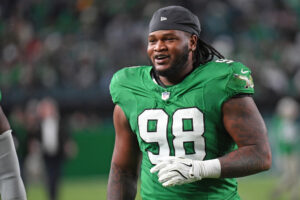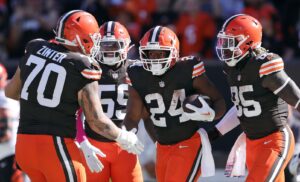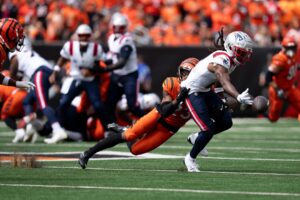On Thanksgiving 1982, Lawrence Taylor was a hot grenade. His pin had been removed early in the fourth quarter of the holiday game by Detroit Lions quarterback Gary Danielson. The Lions had driven deep into the opponent territory on their home turf, threatening a touchdown to break an arduous 6-6 tie game. Danielson had his offensive line prepped to make way for a clean left pass towards running back Horace King. The Lions position themselves in a formation familiar to Taylor’s mental playbook. He prepared his stance for battle.
Timeout; Detroit. Damn. The anticipation built inside his shell. What play would they call instead? Time in. Same formation. Snap! Danielson drops back, and with the exact aim that the New York Giants linebacker had anticipated, shoots the ball towards King as he darts for the sideline. Concurrently, the grenade erupts. No one can even sense the heat of the blaze behind number 56, as he captures the pass, returning it for 97 yards. Skidding by the rump into the end zone, the white-hot inferno resumes white jersey form, and Lawrence Taylor scores his first ever career touchdown, inspiring the Giants to their first win of the season.
Lawrence Taylor: The Legacy of the New York Giants at Pick Number Two
The Giants have three players in the Pro Football Hall of Fame who began their tenure with the organization as first-round draft picks. First was George Connor, drafted in 1946. Frank Gifford was picked from the 1952 class. And then there was LT, who played out his legacy for 13 seasons, all with the G-Men. He was also the last player that the Giants drafted at pick number two.
Thursday, the pressure will be on for the front office to select a success story who will create a legacy comparable to that of the star linebacker who was drafted second overall in 1981, 37 years ago. There is still, of course, the possibility to trade down, but the Giants historically have only ever traded a first-round pick twelve times without receiving another in return. The odds of them doing so again are pretty negotiable. Regardless of Taylor’s shortcomings as a personality, his heritage as a game weapon is something for which to strive.
Approaching the 1981 draft, he was a hot topic. Only two of 28 NFL general managers had said prior to the start of the weekend that if they had the first overall pick, they wouldn’t select Taylor. Luckily for the Giants, one was Bum Phillips of the New Orleans Saints—the man with the power to change the game. After the draft, Big Blue’s choice was criticized by those who had hoped for a running back. George Rogers, the prospect of choice, went to the Saints at number one, but only played seven seasons (the last three were with the Washington Redskins, where he won his sole Super Bowl title in 1987—a year after Taylor won his first of two in New York).
Rookie Season
Taylor’s rookie season was considered one of the greatest in NFL history. He recorded 9.5 sacks, and lead the Giants to the divisional playoffs, where they were defeated by the eventual Super Bowl champion San Francisco 49ers. Despite that loss, the Taylor-led Giants reduced their points allowed by an average of ten per game. He was the only rookie to win either offensive or defensive player of the year. He began to develop his party-boy reputation in that first year, after almost losing his life in a car crash due to reckless speeding. The Giants immediately insured his life for two million dollars.
This was an easy decision for the Giants to make. From the moment the franchise decided to select him at pick number two, they knew he was bound to become an icon. His notoriety as a player is largely to blame on the reckless behavior he exhibited throughout and after his career. It’s impossible to ignore the darkness that has been a presence in Taylor’s life. We all remember his drug history, and the consequences that resulted. We remember the tumultuous tales from the locker room. These instances may define LT’s legacy as a person, but barely make a dent in his legacy on the field.
Legacy
We also recall the 1983 game against the divisional rival Philadelphia Eagles, in which the Giants’ training staff had to hide Taylor’s helmet to prevent the player from returning to the field yielding a sling-held shoulder. In 1988 versus the Saints, Taylor famously played through a torn pectoral and still recorded seven tackles, three sacks, and two forced fumbles. Even in that infamous Thanksgiving game in which Taylor scored his first touchdown, the linebacker was suffering from an injured knee.
In a legendary game against the Redskins in 1985, Taylor sacked quarterback Joe Theismann, resulting in a compound fracture of Theismann’s right leg and ending his nearly 15-year professional career. Taylor immediately removed himself from the pile and screamed for paramedics. Theismann never blamed Taylor for the injury. He had only been doing his job, and his sportsmanship in his fellow athlete’s moment of terror only reflects favorably on LT’s passion for his game.
The legacy of the New York Giants has been decorated for years, and provided the changes that have been made after the struggles of last season are effective, it is safe to say the heritage of Big Blue will continue to be celebrated for years to come. Critics and fans alike can expect to be aroused by whatever the franchise’s new general manager Dave Gettleman choses to do with pick number two in just a number of hours; but the pressure is on for the choosing of a player who will lead a Lawrence Taylor-like football career, maintaining the integrity of the Giants’ past top-five picks.
Main Photo:Embed from Getty Images






